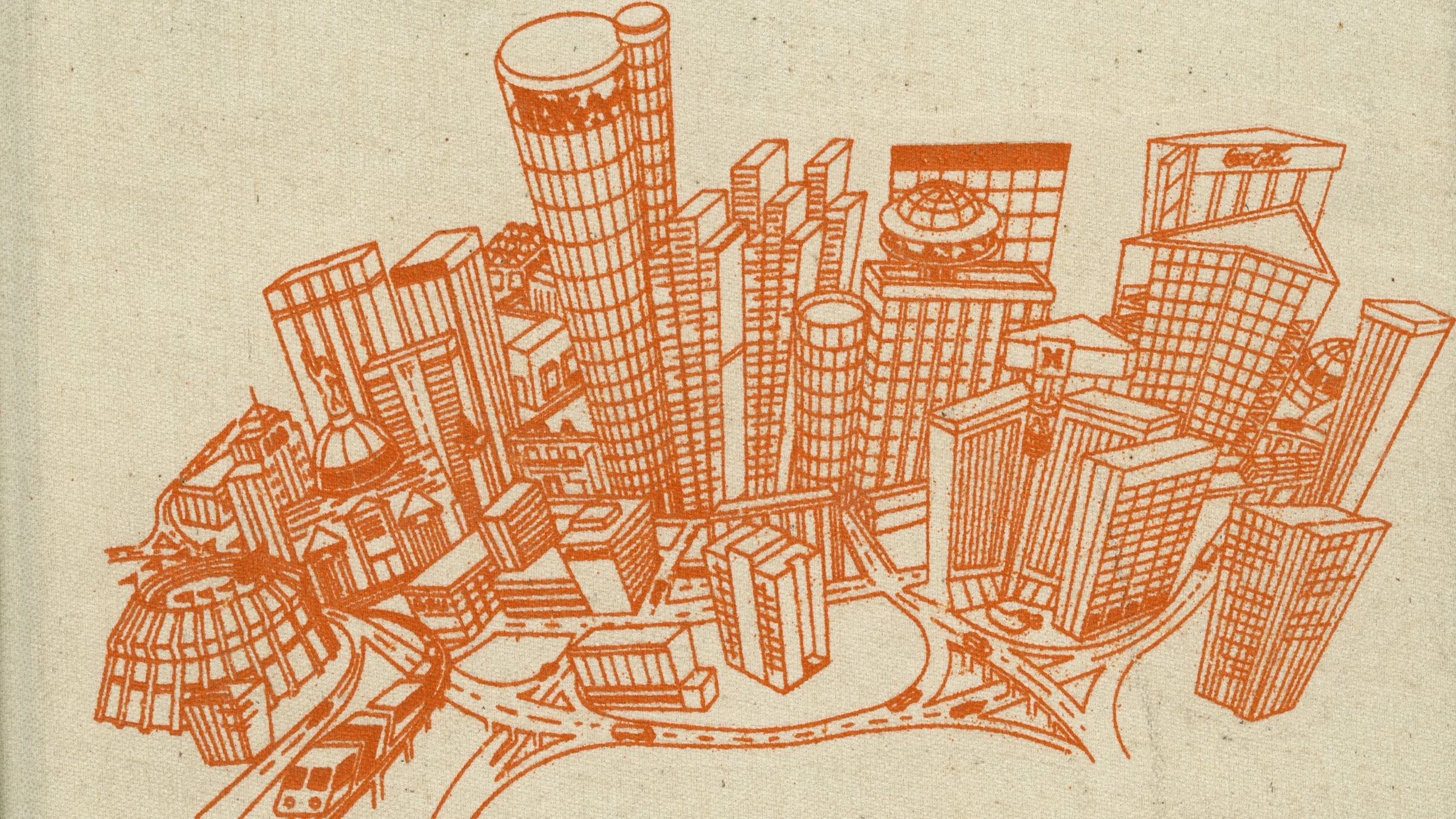Max Ewing’s Closet and Queer Architectural History (Part 1)
This essay is the first of a two-part series. Follow the link to read part two.
Max Ewing’s closet “gallery,” doesn’t look like much (figure 1). It may be familiar to some readers because a photo of the gallery was included in the Gay Gotham exhibition at the Museum of the City of New York (October 7, 2016 – March 26, 2017).[1] Created by Ewing in a small dressing room in his apartment as a sort of 3-D scrapbook of photos, snapshots, and clippings in 1928, it served as a visual memoir of friends, celebrities, and places he admired. It also proved useful as a talking point and magnet for many of those same famous men and women to come to his apartment at 19 West 31st Street, New York, to see themselves in the company of other stars on the walls of his walk-in closet. Despite its small size and the ephemeral character of its contents, Ewing’s closet has significance for architectural history not only because of the ways in which this interior space animates and enlarges our understanding of the apartment and the city in which it is located, but also because it queers the historical narrative by challenging our assumptions and our research process, pushing us to imagine architecture not only as object and form, but also as a matrix for place-making and spatial experiences that change over time.
Figure 1. Max Ewing, Photograph of One Side of Max Ewing’s ‘Gallery of Extraordinary Portraits” in His Clothes Closet, 1928 or 1929. Courtesy: Beinecke Rare Book and Manuscript Library, Yale University, by permission of Wallace Ewing.
In this case as in so many others, we can view the interior as a magnifying lens that allows us to see into the inner lives of queer and non-conforming makers and users, revealing private and often secret dimensions within the built environment that have been largely neglected.[2] Moreover, although Max Ewing would not have shared either our notion of “the closet” as a metaphor for the concealment of queer sexuality or the idea of “coming out of the closet” as a rallying cry for liberation—as both usages are products of the 1960s—he clearly reveled in the idea of creating a personalized interior space that revealed parts of himself to a select group of accepting friends and acquaintances, much in the same way that Philip Johnson created the queer interior of the Brick Guest House at New Canaan some twenty years later.[3] The similarities of the camp irony in the imagery are not coincidental: the two men’s notions of themselves as “homosexuals” were shaped in the same homophobic, U.S. culture in the first half of the twentieth century—indeed, the two men knew each other as members of New York’s gay and interracial social circles in the 1920s.[4] As with Johnson’s Guest House, our challenge here is to read and interpret Ewing’s interior gallery, as well as the project of self-fashioning and self-representation that it reflects, against the grain of our assumptions about architectural style and experience, and as a counter-weight to the preoccupation with exteriors that has dominated the discourse in our field.[5]
“Ewing’s closet has significance for architectural history not only because of the ways in which this interior space animates and enlarges our understanding of the apartment and the city in which it is located, but also because it queers the historical narrative by challenging our assumptions and our research process.”
Born in the town of Pioneer, Ohio, in 1903, Max Ewing was a handsome, charming, young composer and writer who moved to New York City in 1923 to study as a concert pianist. The previous year he had published an effusive appreciation of the writer Carl Van Vechten in the University of Michigan student newspaper, and the article was reprinted in the Detroit Free Press in February 4, 1923 with the title “Carl Van Vechten: One of the Rarest Figures in the Whole Galaxy of Contemporary American Writers.”[6] Van Vechten, just starting out in his career as a novelist, was flattered by the praise, writing to Ewing that he was “ a very nice young man to celebrate me in so delightful a fashion in two cities,” and noting that he would “be delighted to meet” him when he arrived in the fall.[7]
When they met in New York City a few months later, the two men quickly discovered that they had much in common, despite the twenty-three-year difference in their ages: both were gay, both loved opera, movies, celebrities, and cats, and both were avid collectors of people and things, committed letter-writers and record-keepers. Van Vechten introduced Ewing to the social whirl of bohemian and queer circles in the city, taking him to the raucous parties, speakeasies, and nightclubs that were a hallmark of life in “Jazz Age” New York. Ewing’s good looks, wit, and education made him a much-sought-after guest, and he was a frequent escort for both men and women. An injury to his finger forced him to take a break from practicing the piano, and he readily turned his attention to writing for the off-Broadway musical theater, a world in which he soon made many new friends among the dancers, actors, singers, and set-designers he encountered. Most of them were gay men and lesbians.[8] He wrote frequent letters to his parents (often three or four a week) marveling at the invitations he received and the celebrities he met at gatherings across the city, from Greenwich Village, to Park Avenue, to Harlem.[9] Ewing soon became a member of Van Vechten’s inner circle, known as the “jeunes gens assortis,” a group of young gay men, both black and white, recruited as lovers and companions. Ewing’s energy for collecting, his camp sense of humor, and his knowledge of literature, music and the arts made him a particular favorite, not only with Van Vechten but also with Muriel Draper, a writer and interior decorator whose bustling salon was a meeting-place for art-world intellectuals, including many ambitious young men (Lincoln Kirstein, Walker Evans, and Mark Tobey among them) who vied for her attention.[10]
Figure 2. Carrère and Hastings, “The Life Building, 19 West 31st Street, New York City,” Architectural Record 27, no. 1 (January 1910): 32.
Ewing made extended trips to Europe in 1926 and 1927, moving into his two-room apartment on the eighth floor of 19 West 31st Street (known in those years as the “Maison”) in November 1927.[11] The building, by Carrère and Hastings, had been erected in 1894 to house the offices for Life magazine, a humor magazine later bought (and transformed beyond recognition) by Henry Luce; it also included spacious, one-bedroom, kitchenless apartments with living rooms and walk-in closets for its editors, artists, and staff on the upper floors (figure 2).[12] Even after the magazine moved out in the late 1920s, the building continued to function as an apartment hotel for bachelors, and Ewing was particularly proud that his flat had been the studio of the famous illustrator Charles Dana Gibson.[13] There was space for his piano, the living room was perfect for entertaining, and he soon began to use the walk-in closet to display his prized collection of photos and clippings. He pursued a frenzied schedule of lunches, dinners, and all-night dancing at Harlem nightclubs like Small’s Paradise (where he first saw Paul Meeres, “the brown Valentino”) and the Sugar Cane Club (where he heard Bessie Smith and other jazz artists), regularly inviting his new friends to his open-house “evenings” and cocktail parties.[14] Despite the Depression and his narrowing professional opportunities, this pattern continued until 1933, when he carefully packed up all his treasures and moved—although only briefly—to Hollywood to try his hand at screen writing. Max Ewing’s “Gallery of Extraordinary Portraits”—each image numbered and recorded in a printed catalogue—was the culmination of the passions and aspirations of these years (figure 3).
Figure 3, Exhibition Catalogue, Max Ewing Collection of Extraordinary Portraits, 1928. Courtesy: Beinecke Rare Book and Manuscript Library, Yale University, by permission of Wallace Ewing.
Citation
Alice T. Friedman, “Max Ewing’s Closet and Queer Architectural History (Part 1),” Platform, October 10, 2019.
Notes
[1] For Ewing’s biography, see Wallace K. Ewing, Genius Denied: The Life and Death of Max Ewing (Grand Rapids, Mich.: Wallace K. Ewing, 2012). Ewing’s archive is preserved in the Beinecke Rare Book and Manuscript Library, Yale University, YCAL MSS 656.
[2] Ewa Lajer-Burcharth, and Beate Söntgen, “Introduction,” in Interiors and Interiority, ed. Lajer-Burcharth and Söntgen (Berlin: De Gruyter, 2015), 1-3.
[3] Alice T. Friedman, Women and the Making of the Modern House: A Social and Architectural History (New York: Abrams, 1997; Yale University Press, 2007), chap. 4, and Friedman, "Front and Back of House: Staging Queer Domesticity in New Canaan," in Performance, Fashion, and the Modern Interior, ed., Fiona Fisher and Patricia Lara-Betancourt (London: Berg, 2011), 169-81.
[4] Max Ewing, Diary for 1933, entry for January 12: “Cocktails at Philip Johnson’s,” Beinecke Rare Book and Manuscript Library, Yale University, Max Ewing Papers, YCAL MSS 656, Box 30, Box 225. See also Mardges Bacon, John McAndrew’s Modernist Vision (New York: Princeton Architectural Press, 2018), 51-57.
[5] Christopher Breward, “The Closet,” in Queering the Interior, ed. Matt Cook, and Andrew Gorman-Murray (London: Bloomsbury Publishing, 2017), 187-97.
[6] Detroit Free Press, February 4, 1923: 5-6.
[7] Carl Van Vecthen to Max Ewing, January 19 and February 6, 1923, Max Ewing Papers, Box 8, Folders 59-60. See also Edward White, The Tastemaker: Carl Van Vechten and the Birth of Modern America (New York: Farrar, Straus and Giroux, 2014), and Kirsten MacLeod, “Introduction: The Blind Bow-Boy: ‘A Great Forgotten American Novel of the 1920s,’” in Carl Van Vechten, 'The Blind Bow-Boy', ed. Kirsten MacLeod (Cambridge: Modern Humanities Research Association, 2018), vii-xxii.
[8] See George Chauncey, Gay New York: Gender, Urban Culture and the Making of the Gay World 1890-1940 (New York: Basic Books, 1994). For gay Harlem see Bruce Nugent, Gay Rebel of the Harlem Renaissance: Selections from the Work of Richard Bruce Nugent, ed. and with an introduction by Thomas H. Wirth, forward by Henry Louis Gates (Durham, N.C., and London: Duke University Press, 2002) and Kevin J. Mumford, Interzones: Black/White Districts in Chicago and New York in the Early Twentieth Century (New York: Columbia University Press, 1997), chap 6.
[9] For Ewing’s friendship with Esther Murphy and their life in queer New York and Paris, see Lisa Cohen, All We Know: Three Lives (New York: Farrar, Straus, and Giroux, 2012), 7-147.
[10] Kirsten MacLeod, “The ‘Librarian's Dream-Prince’: Carl Van Vechten and America's Modernist Cultural Archives Industry,” Libraries & the Cultural Record 46, no. 4 (2011): 360–87. For Draper, see Steven Watson, Prepare for Saints: Gertrude Stein, Virgil Thomson and the Mainstreaming of American Modernism (New York: Random House, 1998), 172-89.
[11] Ewing Papers, Box 3, Folder 20, November 28, 1927.
[12] For bachelor flats, see Elizabeth Cromley, Alone Together: A History of New York’s Early Apartments (Ithaca: Cornell University Press, 1990), 187-90, and Chauncey, Gay New York, chap. 6.
[13] Max Ewing to Edgar Ailes, Max Ewing Papers, December 27, 1927, Box 6, Folder 37.
[14] For Ewing’s daily round of social engagements, see Ewing Papers, Box 4, Folder 21, passim. A useful map showing the locations of Harlem’s most important clubs and speakeasies was drawn by the African-American cartoonist E. Simms Campbell in 1932.





